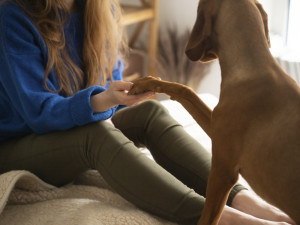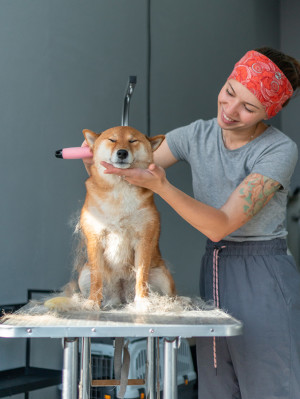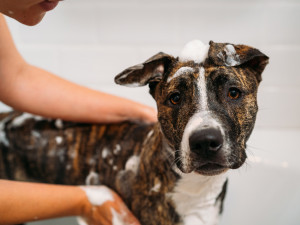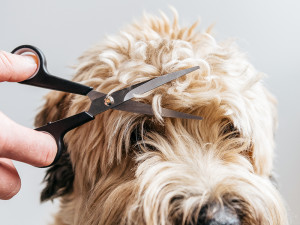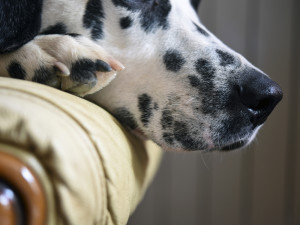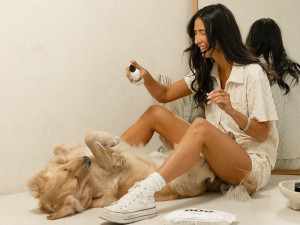Can You Cut a Dog’s Whiskers?
These little guys actually serve a huge role on your dog’s body.
In This Article:
What Do Whiskers Do for Dogs? What Happens If You Cut a Dog’s Whiskers? Common Misconceptions About Cutting Whiskers When Whiskers May Need to Be Trimmed
Have you ever wondered if it’s OK to trim your dog’s whiskers? No, you should not intentionally trim this part of your dog’s face. While it may be tempting to give your furry friend a neat and tidy appearance, it’s crucial to understand the significance of these specialized hairs before reaching for the scissors.
What do whiskers do for dogs?
Believe it or not, your dog’s whiskers serve a purpose beyond making their face extra cute. Whiskers, which are technically known as “vibrissae,” are specialized hairs that grow on a dog’s face. Most dogs have whiskers on either side of their muzzle, above their eyes, on their cheeks, and under their chin.
Whiskers are special because they are actually part of a dog’s sensory system. They’re thick hairs that grow out of a sinus (kind of like a big hair follicle) that has a robust supply of blood and nerves. Whiskers help dogs in many ways, including:
How much do you spend on your pet per year?
Sensory perception and spatial awareness
Depending on their coat type, a dog’s whiskers often lay fairly flat and can be almost invisible if they’re relaxed. When alerted, dogs tense their facial muscles in a way that makes their whiskers stand up, forming a little hairy halo around their face. By projecting their whiskers outward, dogs improve their sense of what’s going on around them. The super-sensitive hairs can pick up minor changes in air currents, which can alert them to the location of prey or predators in the area.
Navigation
A dog’s whiskers help them to feel their environment. Dogs don’t have the best vision, so having an extra sense to help them navigate their surroundings is a big help. Although similar studies haven’t been performed in dogs, other mammals like rats have been shown to use their whiskers to navigate in the dark, finding their way along walls and around objects by contact with their whiskers.
They also use their whiskers to figure out if they can fit through an opening, decreasing the risk of getting stuck in a narrow passageway.
Communication and emotional expression
Dogs can also use their whiskers as a way to tell other dogs (and perceptive people) how they’re feeling. Flared whiskers on a dog may indicate that a dog is unhappy about the current situation, while whiskers that are pinned backwards are often a sign of fear.
Protective mechanism for the eyes and face
The long length of a dog’s whiskers allows them to feel objects or changes in air pressure. This gives them time to flinch away from a potentially dangerous object before it reaches their head. Dogs will usually blink and move away when their whiskers are touched to help protect their eyes and face.
What happens if you cut a dog’s whiskers?
Many pet parents who groom their dogs at home have accidentally cut a dog’s whisker off at some point. Dogs can get very twitchy when clippers are near their face and may jerk suddenly, resulting in some unintentionally trimmed hair or whiskers. Accidentally cutting off a whisker or two shouldn’t cause any big issues beyond a temporary surprise.
Professional groomers and show dog parents may want to trim a dog’s whiskers to give their face a more sleek, “finished” appearance. But are you supposed to cut a dog’s whiskers? While cutting whiskers is unfortunately still permissible in AKC standards for many breeds, the requirement to trim whiskers seems to have been eliminatedopens in new tab, especially for specific breeds.
Completely removing a dog’s whiskers for cosmetic reasons is actually prohibited in some countries. This is because the whiskers are part of a valuable sensory organ and removing them without cause is akin to amputating a useful body part. While this may seem dramatic, trimming a dog’s whiskers can result in difficulties for them, including:
Your dog could have impaired sensory perception.
Without whiskers, dogs lose one of their major ways of sensing what’s happening near them. They can’t feel changes in wind currents, movement, and nearby objects as effectively.
They could also have a reduced ability to navigate.
Dogs whose whiskers have been trimmed may have trouble feeling things around them. This can be especially important for dogs with failing eyesight that use their whiskers to fill in some missing information about their surroundings.
Even if your dog has perfect vision, those sensory hairs still help them with tasks as simple as drinking and eating — the whiskers under their chin and on their muzzle help them feel the food bowl and make sure their head is properly oriented.
You could increase their stress.
Because dogs use their whiskers to help form a picture of the world around them, removing their whiskers makes them more uncertain about their environment. Animals with their whiskers removed show more hesitation when approaching objects, likely because they can’t get as good a feel for distances, sizes, and potential dangers without their whiskers.
There’s potential for injury.
Because whiskers help dogs sense dangers before they reach their face, trimming their whiskers slows their reaction to potential threats. Dogs with poor vision or dogs navigating dark areas may also be more likely to run into things without the help of their whiskers in feeling the area out.
Common misconceptions about cutting whiskers
Because dogs are people pleasers and adept at adjusting to new things, many people don’t notice changes after removing their dog’s whiskers. This doesn’t mean that dogs aren’t affected by trimmed whiskers though. Some common misconceptions about cutting dog whiskers have cropped up over time:
Whiskers are purely aesthetic.
Whiskers are part of a dog’s senses, allowing them to more fully picture and experience their surroundings. In addition to their sensory aspects, whiskers allow dogs to signal information about their attitude to other animals. Whiskers serve a much bigger purpose for dogs than simple hairs.
Removing whiskers is painless
You may wonder: If you cut a dog’s whiskers, will it hurt them? Fortunately, cutting a whisker isn’t painful for dogs. It may be a little weird for them due to the number of nerves that supply each whisker. Plucking a whisker is a big no-no, though. Whiskers are firmly attached to very sensitive tissue, and pulling on them in any way is not a nice thing to do. Plus, plucked whiskers will bleed a good bit because of the rich blood supply at their base.
Whiskers will grow back quickly.
Whiskers take a long time to grow back once removed. Many don’t even begin to regrow until a dog’s next shedding cycle, and it can take months for them to reach their full length. Don’t panic if you notice a stray whisker on the floor of your house though. Dogs will shed their whiskers like other hair, just not as frequently. Losing an occasional whisker is expected.
When whiskers may need to be trimmed
Unfortunately, cutting a dog’s whiskers does become necessary at times. It’d be rare to need to cut all the whiskers on a dog’s head though. Usually, dog whiskers are trimmed by a veterinarian when there’s a problem in the area. This may be due to problems like:
A cut or scrape that needs a clean area to heal
Surgical site preparation
Removal of a nearby mass
Abnormal whisker growth (a whisker that rubs on an eye or is growing beneath the skin)
Veterinarians will generally try to remove as few whiskers as possible to leave your pup with as much sensation as possible. It may take your dog a little bit of time to adjust to their missing whiskers, but they should bounce back to normal before long.
FAQs (People also ask):
Can you cut a dog’s whiskers while grooming?
Cutting a dog’s whiskers for cosmetic purposes is not recommended because a dog’s whiskers are part of their senses. They help dogs to navigate and be aware of their surroundings. They shouldn’t be removed unless necessary.
How often should you groom your dog?
Every dog’s grooming needs are different. Some dogs need daily maintenance to keep their coats healthy and knot-free, while others are happy to run and play for weeks without a thought about being groomed.
If you cut a dog’s whiskers will it hurt them?
Cutting a dog’s whiskers may be uncomfortable for them due to the large number of nerves that help them sense their surroundings. Cutting a whisker should not cause pain, but it can affect dogs negatively in other ways.
References:
What Can Whiskers Tell Us About Mammalian Evolution, Behaviour, and Ecology?opens in new tab
That Dog Won’t Fit: Body Size Awareness in Dogsopens in new tab





